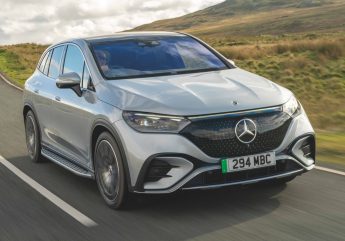
Think of this as an SUV version of the EQE saloon, sharing some styling features. Like the saloons, the EQE SUV looks like a (slightly) scaled-down EQS SUV. This means that again, the front has a surprisingly short overhang thanks to a lack of engine and continues the cab-forward look first seen on the EQS saloon – although in SUV form. There are the same large headlights, and faired-in grille with Mercedes logo detailing. At the side, there’s the same powered flush door handles we’ve already seen on other EQS and EQE models, while at the back it also gets a curvy rear light bar.
Inside, you could be forgiven for thinking you’re sitting in a slightly smaller EQS SUV, with the same soft leather on the seats, the flat, minimalist dashboard, which also included the optional extra Hyperscreen on the passenger side of our test car. We’re not sure that the extra screen is useful enough to warrant this package’s eye-watering £7,995 price. Elsewhere, there’s the general level of spaciousness we’ve come to expect from Mercedes EQ EV products. Our car had the excellent 12.8in central touchscreen, running Mercedes’ latest MBUX infotainment system, which despite all its technology, is easy to use. The AMG Line Premium Plus equipment grade adds niceties, such as the excellent Burmester audio system.
The EQE SUV’s driving position is comfortable and multi-adjustable, working better here, because we think it’s higher up. Although we wonder whether shorter drivers will be as happy. The one-piece seats are supportive and there’s impressive levels of stowage around the driver and front passenger. Move to the back, and legroom levels are equally spacious.
As for the driving experience, it’s much the same as the bigger EQS SUV. You start it via a button, then engage drive via the right-hand column stalk (as you would on any Mercedes model). Behind the steering wheel there is a chunky set of paddles, which work the three levels of brake recuperation – it works well. Eco seems to be the best for regen and one-pedal driving. Comfort is like Eco – but without the regen and equals an oddly floaty ride. With Sport being the most dynamic and involving.
Like the EQS, the brakes have an odd feel, as initially there’s lots of travel, but they also lack feel and as such are hard to modulate – which is a concern when slowing this 2.5-tonne SUV down from national speed limits.
Our EQE SUV was fitted with 22in alloy wheels and air suspension as standard. Yet despite the raised stance, the ride in general is wonderfully serene – although at speed we did notice some vibrations. In 350 form, we feel the EQE was developed for comfort rather than dynamism. For example, the steering with its standard rear-steer, makes manoeuvring around town very easy – but can make the steering feel oddly disconnected at speed. You can feel the weight most in corners, and road undulations – where you quickly find this Mercedes’ limits.
We had the EQE SUV 350, which is at the bottom of the EQE range, and is expected to gain the most fleet interest. It has an 89kWh battery and 288hp, via twin motors. This means 62mph acceleration in 6.6 seconds and a top speed of 130mph. However, despite the impressive performance, this EQE SUV still boasts up to 323 miles on a charge. Talking about charging, with rates up to 170kW, this SUV isn’t at its best when home-charged. It’s possible to go from 10-80% charge in just 31 minutes, via a 170kW public charger.
We wish the EQE SUV had more character, but it impresses with its high levels of refinement, ride, and performance.
Mercedes EQE 350 SUV AMG Line Premium
P11D: £99,205
Residual value: 44.1%
Depreciation: £54,650
Fuel: N/A
Service, maintenance and repair: £3,220
Cost per mile: N/A
Range: 323 miles
CO2 (BIK %): 0g/km (2%)
BIK 20/40% a month: £33/£66
Luggage capacity: 520 litres
Battery size/power: 89kWh/288hp





